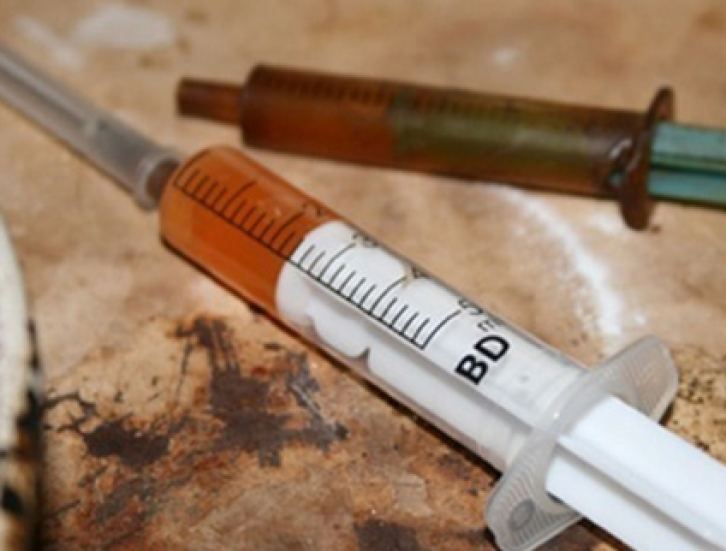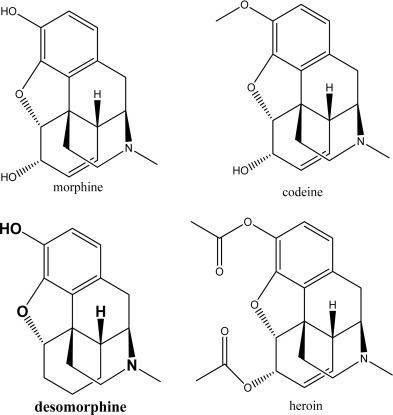Trade names Permonid ATC code none | Addictionliability Very high Molar mass 271.354 g/mol | |
 | ||
Dependenceliability Physical: Very highPsychological: Very high Legal status AU: S9 (Prohibited)CA: Schedule IDE: Anlage I (Controlled)UK: Class AUS: Schedule I Synonyms Desomorphine, dihydrodesoxymorphine, Permonid | ||
Desomorphine
Desomorphine (dihydrodesoxymorphine, former brand name Permonid, street name krokodil) is a derivative of morphine with powerful, fast-acting opioid effects, such as sedation and analgesia. First synthesized in 1932 and patented in 1934, desomorphine was used in Switzerland under the brand name Permonid and was described as having a fast onset and a short duration of action, with relatively little nausea or respiratory depression compared to equivalent doses of morphine. Dose-by-dose it is eight to ten times more potent than morphine.
Contents
- Desomorphine
- Medical
- Recreational
- Toxicity
- Reinforcement disorders
- Chemistry
- History
- Legal status
- North American media
- References

Desomorphine is derived from morphine where the 6-hydroxyl group and the 7,8 double bond have been reduced. The traditional synthesis of desomorphine starts from α-chlorocodide, which is itself obtained by reacting thionyl chloride with codeine. By catalytic reduction, α-chlorocodide gives dihydrodesoxycodeine, which yields desomorphine on demethylation.
Medical

Desomorphine was previously used in Switzerland and Russia for the treatment of severe pain; although for many years up to 1981, when its use was terminated, it was being used to treat a single person in Bern, Switzerland with a rare illness.
Recreational
Desomorphine abuse in Russia attracted international attention in 2010 due to an increase in clandestine production, presumably due to its relatively simple synthesis from codeine available over-the-counter. Abuse of homemade desomorphine was first reported in Siberia in 2003 when Russia started a major crackdown on heroin production and trafficking, but has since spread throughout Russia and the neighboring former Soviet republics.

The drug can be made from codeine and iodine derived from over-the-counter medications and red phosphorus from match strikers, in a process similar to the manufacturing of methamphetamine from pseudoephedrine. Like methamphetamine, desomorphine made this way is often contaminated with various agents. The street name in Russia for homemade desomorphine is krokodil (Russian: крокодил, crocodile), possibly related to the chemical name of the precursor α-chlorocodide, or similarity of a skin, damaged by the drug use, to crocodile leather. Due to difficulties in procuring heroin, combined with easy and cheap access to over-the-counter pharmacy products containing codeine in Russia, use of krokodil increased until 2012. In 2012 the Russian federal government introduced new restrictions for the sale of codeine-containing medications. This policy change likely diminished, but did not extinguish krokodil use in Russia. It has been estimated that around 100,000 people use krokodil in Russia and around 20,000 in Ukraine. One death in Poland in December 2011 was also believed to have been caused by krokodil use, and its use has been confirmed among Russian expatriate communities in a number of other European countries.
Toxicity

Illicitly produced desomorphine typically contains large amounts of toxic substances as a result of being "cooked" and used without any significant effort to remove the byproducts and leftovers from synthesis. Injecting any such mixture can cause serious damage to the skin, blood vessels, bone and muscles, sometimes requiring limb amputation in long-term users. Causes of this damage are from iodine and phosphorus (and other toxic substances) that are present after synthesis. The large volume of tissue damage/infection is what gained the drug its nickname of the flesh-eating drug, as homemade versions made by suppliers and users contain multiple impurities and toxic substances that lead to such tissue damage/infection (the pure form of the drug itself would not cause this damage). Gangrene, phlebitis, thrombosis (blood clots), pneumonia, meningitis, septicaemia (blood infection), osteomyelitis (bone infection), liver & kidney damage, brain damage and HIV/AIDS are also common amongst users of krokodil. Sometimes, the user will miss the vein when injecting the desomorphine, creating an abscess and causing death of the flesh surrounding the entry-point. Test subjects were subjected to desomorphine intake. The completed tests on animal subjects produced results that contrast desomorphine to morphine. Compared to morphine, the results show increased toxicity, more potent relief of pain, higher levels of general depression, decreased respiration, and increased digestive activity.
Reinforcement disorders
Early medical trials of humans taking desomorphine have resulted in the finding that, like morphine and most other analgesics of the morphine type, small amounts are highly addictive and tolerance to the drug develops quickly. However, though tolerance to respiratory depression with repeated doses was observed in rats, early clinical trials failed to show any tolerance to these same effects with repeated doses in humans.
Chemistry
Desomorphine has a molecular weight of 271.35 g/mol and three salts are used: hydrobromide (free-base conversion ratio 0.770), hydrochloride (0.881) and sulfuric acid(0.802). Its freebase form is slightly soluble in water (1.425 g/L at 25 °C), although its salts are very water-soluble; its freebase form is also very soluble in most polar organic solvents (like acetone, ethanol and ethyl acetate). Its melting point is 189 °C. It has a pKa of 9.69. Desomorphine comes in four isoforms, A, B, C, and D and the latter two appear to be the more researched and used.
Krokodil is made from codeine mixed with other substances. The codeine is retrieved from over-the-counter medicine and is then mixed with ethanol, gasoline, red phosphorus, iodine, hydrochloric acid and paint thinner. Toxic nitrogen oxide fumes emerge from the drug when heated.
History
Desomorphine was first synthesised in the U.S. in 1932 and patented on November 13, 1934. In Russia, desomorphine was declared an illegal narcotic analgesic in 1998. However, while codeine-containing drugs generally have been prescription products in Europe, in Russia they were sold freely over-the-counter until June 2012. The number of users in Russia was estimated to have reached around one million at the peak of the drug's popularity.
Legal status
In the US, desomorphine is a Schedule 1 controlled substance, indicating that the United States FDA has determined that there are no legal medicinal uses for desomorphine in the U.S. It has maintained this status as a controlled substance in the United States since 1936. The drug is a Narcotic in Schedule I of the Controlled Substances Act 1970 of the United States as drug number (ACSCN) 9055. It is therefore subject to annual aggregate manufacturing quotas in the United States, and in 2014 the quota for desomorphine was 5 grams. It is produced as a hydrochloride (free base conversion ratio 0.85) and sulphate (0.80)
North American media
The media in the U.S. and Canada have brought awareness to desomorphine. There have been incidents reported where desomorphine had supposedly been present within either country but no incidents have been confirmed by any drug-testing reports.
